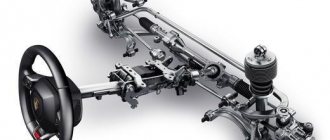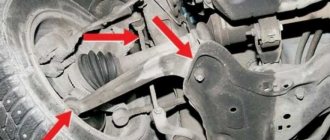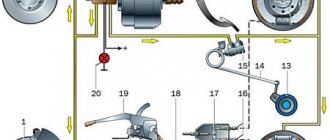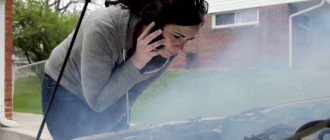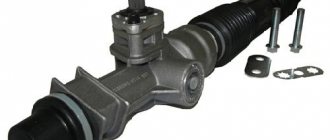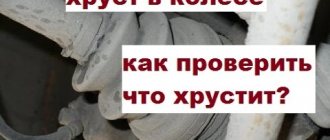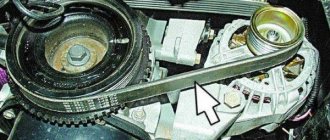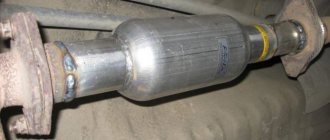Extraneous sounds, noises and even rattles are an integral part of any car after many years of operation. It is sounds and humming that are uncharacteristic of driving that can be considered clear signs of a breakdown or malfunction in any component of the vehicle.
In most cases, grinding and creaking do not indicate breakdowns, but the incorrect (faulty) operation of some mechanism. Often these problems are only detected under certain conditions - for example, when turning the steering wheel.
How to determine the cause of squeaking and grinding noises when turning the steering wheel
It is important that extraneous noise while the car is moving can appear at any speed.
The driver, turning the steering wheel in one direction or another, hears an uncharacteristic grinding sound even when driving at a speed of 30 km/h. It is noteworthy that when turning the steering wheel, a grinding noise can be heard even when the car is standing still. Modern car models are equipped with power steering (power steering), thanks to which the steering wheel rotates as easily and silently as possible. For basic configurations, a slight hum or hissing sounds are allowed when the steering wheel is turned to extreme positions. However, there should be no grinding or squeaking noise regardless of whether power steering is installed or not.
Determining the cause of uncharacteristic noises when turning the steering wheel is not easy. The first step is to establish not only the source of uncharacteristic sounds, but also additional symptoms. Indeed, in a number of cases, the driver not only hears unusual sounds, but also feels any problems with the controls.
When diagnosing the cause of noise, several important factors must be taken into account:
- specificity of noise (humming, creaking, grinding, crunching, knocking);
- moments when noise appears (grinding noise when turning the steering wheel while moving or while the car is parked);
- frequency of noise - depending on weather conditions, engine temperature, vehicle load and other factors;
- the appearance of a grinding noise when turning the steering wheel left or right, or in both directions;
- What other symptoms appear along with the noise?
Complete answers to these questions will help a car service specialist determine the source of the problem as accurately as possible and eliminate it.
Chip errors
When a situation is observed that the wheels turn on their own, the reason is the electronic filling of the Priora electric power steering control unit.
As mentioned above, quality was sacrificed for the sake of economy. Now the situation with this seems to have improved and everything has been finalized, but if suddenly you feel that the steering wheel is starting to move by itself, go for repairs. If, along with the electric power steering, the speedometer also fails, then you need to look at the speed sensor. It was either simply dirty or broken. The same applies to the torque sensor installed on the amplifier. Clean them well and check their functionality.
What can cause a squeaking or knocking noise when turning the steering wheel?
First of all, when extraneous sounds occur when the steering wheel moves, you need to perceive it as a red alarm light. Failure of steering control at speed, or inadequate steering control, can cause serious accidents. Therefore, it is necessary to find and fix the problem immediately.
Creaks when turning the steering wheel, both while standing still and while driving, can be caused by various reasons. The following may creak and make noise:
- steering column;
- steering rack;
- power steering;
- CV joints;
- ball joints;
- silent blocks;
The steering column can creak, both due to wear of individual parts, and due to poor lubrication. In particular, if there is a cardan in the steering column, it needs to be lubricated and checked. It is also worth checking the steering coupling and other elements of the column. As a rule, the creaking that occurs in the steering column is accompanied by the appearance of play on the steering wheel. But this is by no means an axiom.
In systems with electric power steering, this same power steering can be located either in the column itself or between the steering column and the steering rack. Accordingly, extraneous noise may occur due to ESD malfunctions.
conclusions
Any vehicle is a complex system consisting of thousands of different components. Therefore, various kinds of noise can appear both due to serious problems in the mechanisms, and due to the weakening of any simple element in the interior.
However, the car owner must carefully monitor the appearance of various kinds of sound effects both while the car is moving and when turning the steering wheel while parked. After all, only timely diagnosis of a problem can be considered the key to successful repair and safe driving.
It should be borne in mind that any difficulties that arise with turning the steering wheel must be resolved immediately, since the problem may result in the failure of one of the elements of the control system and an accident. You should not ignore the appearance of sounds uncharacteristic of vehicle operation, since the safety and even lives of people depend on it.
The plastic casing creaks
Every driver knows that when actively using a car that is not of the best build, “crickets” will appear over time. They represent creaks of the front panel, including the steering casing, made of plastic. This problem is solved in various ways, depending on the car model.
If all the parts described above have been inspected and the cause of the squeak cannot be determined, it is also recommended to check the power steering drive belt and brake elements, especially the pads and discs.
Battery problems
Based on this, we can draw the first conclusions about the cause of the breakdown. A common cause of malfunction is low voltage in the on-board network. The fact is that for the amplifier to function, a supply voltage of 13.5V is required.
First of all, we test the battery, if everything is fine with it, then we’ll look into it further. The problem may have occurred when you removed the battery for charging. To make the electric booster work again, turn the wheels to the extreme position and back 5-6 times, very often this is enough to resume operation.
Steering rack
The cause of a squeak when turning the steering wheel may be a faulty steering rack. Here there is damage to the anthers, leakage of the seals, wear of the rack elements, and other sores. A creaking sound, for example, may occur due to the fact that the steering ends are actively in contact with the steering rods. And in the event of severe accidents or other road troubles, deformation of the body of the rack itself may occur. And this deformation can also cause squeaking when turning the steering wheel. Generally speaking, the steering rack of modern cars is a complex mechanism that only professionals can repair. The worm gear, which was used in steering earlier, was much simpler and more reliable, but steering with its help was much more complex and less convenient. On your own, you can inspect the anthers, perhaps check the condition of the steering tips, rods, and if you are lucky, you will find leaks in the steering rack seals. But troubleshooting will still have to be done by a specialist.
Major failures of the EUR
Experienced drivers and Prior owners can observe the following trend - breakdowns occur in the same parts, weak points of the system. Why is this happening?
The first thing you need to pay attention to is the operation of the electric power steering. After the system has been completely turned off, a code should appear on the on-board computer - it reports the cause of the breakdown. Each code has its own interpretation. However, very often the real reason for the cessation of operation of the amplifier can be determined only after a full diagnosis has been carried out. In order to find out about the nature of the breakdown of the Lada Priora electric power steering, do the following:
- The engine is turned off and the steering wheel is turned a couple of times.
- The engine turns on and the steering wheel turns several times.
It is quite possible to drive with the system turned off, but it is not recommended. It is very difficult to understand the features of control with and without an electric booster. Therefore, it is better to perform a diagnosis. It will help determine which component has failed, whether it can be repaired or whether it is better to replace it with a new one.
Sometimes you can observe the following situation: the speedometer and the sensor stop functioning at the same time. This most often occurs due to a malfunction of the speed sensor. The sensor provides data to the control unit, which processes the information on the speedometer and determines the supply of the required amount of force.
If the cause of the breakdown is the sensor, the solution to the problem is simple. It is enough to check the quality of the wires and, if necessary, replace them with new ones. If the wires are in good condition, it is recommended to replace the sensor itself.
Fuse removal process
If, during smooth and smooth movement forward, the car turns sharply to the side, it is recommended to carry out unscheduled diagnostics. After all, such unpredictable behavior of the Priora’s electric power steering will not happen without emergency situations. Park and unplug the unit: Disconnect the fuse to stop power supply to the amplifier.
To remove the fuse, you need to do the following:
A car malfunction indicates problems with the ESD. There can be many reasons for this, the breakdown of one part or several. To determine the cause as accurately as possible, seek specialized diagnostics. And you can replace or repair a damaged part yourself.
The process of removing the electric amplifier
If you decide to replace the electric power steering on a Prior car or make sure that its individual parts are in working condition, you need to remove the unit completely. For this you will need:
- chisel;
- head for 8 or 13;
- extension;
- ratchet.
The process of removing the EUR is simple and fast. The process is lengthy: you need to remove the steering wheel, grab the airbag, then remove the cover and finally, the ignition switch. After all this, you can take out the electric amplifier.
Wheel alignment
Let's start with a fairly common reason due to which a grinding noise is heard from the wheels when turning the steering wheel of a car while driving or in a parking lot.
If the sound comes from there, then there is a high probability that there are no problems with the steering. But the wheels are positioned incorrectly. When problems appear after a wheel alignment, it was probably simply done incorrectly.
If you set the front axle wheels incorrectly, the tires will begin to wear out quickly and unevenly.
Most often, such a nuisance occurs among those who save on car service and decide to carry out the wheel alignment themselves.
Here it is better to visit a service station, perform computer diagnostics and carry out professional balancing.
Repairing the EUR on-board computer
As for the “brain” and internal sensors, the procedure is as follows: to fix broken sensors, it is better to go to a service station, but you can change the computer at home. Tools that need to be used to work with the equipment:
- socket wrench 8;
- socket wrench 13;
- shaped screwdriver.
It is necessary to first remove the steering wheel.
Tie Rod Ends
Another reason why the steering wheel squeaks uncharacteristically when rotating may be a faulty or worn tie rod end.
If you hear an unpleasant squeak in the cabin directly when turning the steering wheel in place or while driving, first check the traction boot. It may become deformed and damaged. As a result, debris, sand and other contaminants penetrate into the draft. They contribute to the appearance of a squeak, which becomes audible to the driver. First, assess the condition of the boot. If there are signs of breaks, replacement is needed.
If the boot ruptures, you will have to replace the entire pair of tips with all additional elements.
Tips can be classified as those steering control elements that can potentially be replaced with your own hands. But first you should read the instruction manual.
It is extremely rare that the tip creaks because it rubs with adjacent elements. In this situation, changing the position of the elements and replacing the anthers themselves will help.
If only one tip is worn or deformed, both elements still need to be replaced.
There are other possible causes of squeaking and grinding noises.
Steering knuckle bearings
If, when turning the steering wheel, the driver hears an uncharacteristic squeak, which can sometimes appear quite suddenly, it is worth listening to the steering knuckle.
When the sound comes from there, the cause most likely lies in worn bearings.
These bearings can squeak and make cracking noises if there is no lubricant inside or if sand or other abrasive contaminants have entered the housing.
Untimely replacement can have dangerous consequences. It is recommended to remove the bearing from the steering knuckle and check it for defects. If they are not there, lubricant is added and the part is returned to its place. If defects are detected, a new bearing similar to the previous one is used.
Crunching when cornering in front wheel drive cars
It also happens that the car crunches when entering a turn. Moreover, the sharper the turn and the higher the speed, the more characteristic and louder the crunching noise produced. It seems that this crunch does not depend on the turn of the steering wheel, but comes precisely during a turning maneuver on the road and is emitted from under the wheel that bears the load - that is, the wheel on the outside of the turning path. At the same time, the crunch most often occurs when turning only in a certain direction: to the right or to the left.
This crunch is typical only for front-wheel drive or all-wheel drive vehicles. And the cause of the crunching noise when turning the car is the CV joint, better known among common people as a “grenade”.
A CV joint is a connection that allows the front wheel to turn in all directions at a certain angle while maintaining a constant axle speed. Because the CV joint is constantly spinning and under severe stress, it sometimes wears out and must be replaced.
When the shock absorber is faulty
Sometimes the cause of the noise is the creaking of the support bearing when turning the steering wheel. If creaking and howling noises occur no matter which way you turn, check the shock absorbers. Often the problem is in the bearings of this unit. It may be enough to remove any dirt that has clogged up under the boot. How to diagnose? Read on.
Try turning the steering wheel while standing still. Even better, ask an assistant to “steer”, while you listen and watch the movement of the shock absorber spring into the gap between the upper edge of the tire and the wing arch. If the part turns jerkily, as if something is interfering with it, it means that the support bearing creaks when turning the steering wheel. It's simple. There is no movement - neither the transmission nor the hubs can make noise - the shafts and wheels do not rotate. In this case, the only thing to suspect is the shock absorber struts.
Whistle or hum when turning the steering wheel
A hum or whistle when turning the steering wheel is typical for cars with various types of power steering. Rarely does a whistle occur when the steering wheel is turned to one side.
If you hear a whistle when turning the steering wheel all the way, it may be worth tightening the belt with a roller. Or a pump malfunction. Experienced technicians advise not to leave the car with the wheels turned out, as the power steering fluid may boil, which will lead to pump failure.
Also, turning the steering wheel to extreme positions increases the load, causing extraneous noise. In order for the car to last longer, and the driver and passengers to feel safe, it is worth having the car diagnosed at least once every six months.
Understand the nature and nature of extraneous sounds, when they began and the possible reasons causing the noise. Then it will be easier to identify the cause and solve the problem faster.
Systematic diagnosis of all noises
To avoid big problems and breakdowns of your car, you need to monitor its condition. We recommend inspecting your car on a lift or in a pit at least once every couple of months. Particular attention should be paid to metal structures and threaded connections. Don't forget to inspect the wheels; you need to check all fastening connections.
The condition of the car must be carefully monitored
Tighten the bolts and nuts, if you see that any structure is loose, then bring it into proper condition. Try to find time to carry out such work, then your car will last you much longer!
Other causes of squeaking in the wheel when turning the steering wheel
Often, creaking and noise in the wheel area when turning the steering wheel appears due to worn support bearings on shock absorber struts, dried out silent blocks, etc. The nature of the problems can be specific and depend on each specific car model and its steering system, as well as on the specific situation.
Today, the global automotive industry produces a huge number of passenger vehicles with a variety of steering systems. Therefore, in addition to the well-known reasons for squeaking in the wheel area when turning the steering wheel in different situations for each model, there may also be specific ones that are inherent in a given system or several systems.
The general rules for the process of detecting where the sound is coming from are to check all the moving structural elements involved in turning the wheel. You should study each mechanism and element related to the steering shaft, traction, suspension, and wheels. For example, extraneous squeaks and noises can come from a loose bolt or screw when it comes into contact with moving parts.
Knocking, squeaking or humming when turning the steering wheel - what could be the reasons? Video
Elimination method
The method for eliminating squeaks when turning the steering wheel is quite simple. First you need to find the cause and element that makes extraneous sounds. If the outer hinges are worn, they should be replaced. If the front wheel bearings are worn out or the hub nut is loosened, these fasteners must be tightened and the bearings replaced.
In cases where a spring creaks when turning the steering wheel in different directions, it means that it is broken. It needs to be replaced, and it is advisable to do it in pairs at once.
If the steering wheel, steering column bracket, steering mechanism, rack adjusting bolt, steering rod ball pins, or bolts securing the lower flange of the elastic coupling on the gear shaft make knocking noises when turning the steering wheel due to loose fastening, then tighten the threaded connections and adjust the steering column.
Service
In order for the steering to work properly, the driver must know how to properly maintain and operate it. To do this, you should carry out maintenance: change the oil in the power steering pump, if the tips or steering rods are worn, replace them with new ones, check the wheel alignment and adjust them if the angles do not match. Spare parts and oil must be from high-quality and original manufacturers. During operation, the driver must monitor the condition of the steering and the proper operation of the hydraulic or electric booster.
There must also be no air in the hydraulic system. This will ensure a moderate load on the device pump. Check the tightness of the bolts in the connections of the steering linkage or the mounting of the steering mechanism to the body, as well as the tightness of the electric motor or pump. If there is a lot of play on the rack, it can be tightened. But try not to overdo it. As a result, even with power steering, you will have tight and uncomfortable steering. While standing still, it is not recommended to turn the wheels too much. Do not twist them all the way. This will reduce the load on the steering rack, drive belt and pulleys, power steering pump or electric motor. Also, after turning the car’s wheels in place, you should not move away abruptly and rev the engine. This significantly accelerates the wear of steering parts. In addition, the service life of constant velocity joints will be reduced if the car is front-wheel drive. If the mechanism uses a cardan drive, it is recommended to periodically lubricate the joints. This is done by extrusion. Litol universal lubricant is used. It can be used for injection of car king pins if the design uses an independent beam at the front.
Repair is an expensive procedure
The use of the latest technology in car production is by no means considered the only advantage; there is also a disadvantage. An improved new mechanism in a car is a difficult job for a car mechanic, since there are not so many specialists in repairing new components. Although all the components are as perfect as in European countries, no one has seen their former cheapness for a long time. Many people remember how little spare parts for VAZ cars used to cost. Nowadays these can hardly be found anywhere, so you have to buy not very expensive components, most often made in China, which in turn can break again.
It is for this reason that a driver who buys a domestic car is at greater risk, since if it breaks down, he will have to spend the same amount as if a European car breaks down. According to the same criteria, the price of diagnostics also increases, which is why nowadays it is so important to learn how to conduct independent diagnostics.
We hope that you were able to remember a lot from our article, now you can quickly diagnose a car breakdown. Try to pay attention to even small noises, because they may hide a serious breakdown. You definitely don’t want this, so carry out self-diagnosis more often and sometimes visit a service station. We wish you success and may your car never break down!
5/5 — (6 votes)
Bottom line
If it so happens that your car’s bearing is humming when turning right or left, don’t put off repairs. Contact a car repair shop. If you have the skills, you can replace the wheel bearing yourself. The main thing is to do it on time. If the hum is barely noticeable, use Suprotek tribotechnical restoring lubricant. As practice shows, in this case you can count on 10-15 thousand kilometers without much risk.
Well, when the noise intensifies, rattling or crunching sounds are added at the beginning of movement - urgently replace the bearing.
Sources
- https://shosse.ru/remont/rulevaya-sistema/chto-delat-i-kak-ispravit-esli-slyshen-skrip-i-skrezhet-pri-povorote-rulya/
- https://AvtoNov.com/%D1%81%D0%BA%D1%80%D0%B8%D0%BF-%D0%BF%D1%80%D0%B8-%D0%BF%D0%BE %D0%B2%D0%BE%D1%80%D0%BE%D1%82%D0%B5-%D1%80%D1%83%D0%BB%D1%8F/
- https://okeydrive.ru/pochemu-skripit-rul-pri-povorote-osnovnye-prichiny/
- https://DriverTip.ru/osnovy/skrezhet-ili-skrip-pri-povorote-rulya.html
- https://rad-star.ru/pressroom/articles/skrip-v-kolese-pri-povorote-rulya/
- https://howcarworks.ru/%D0%B2%D0%BE%D0%BF%D1%80%D0%BE%D1%81/%D1%81%D1%82%D1%83%D0%BA- %D1%81%D0%BA%D1%80%D0%B8%D0%BF-%D0%B8%D0%BB%D0%B8-%D0%B3%D1%83%D0%BB-%D0% BF%D1%80%D0%B8-%D0%BF%D0%BE%D0%B2%D0%BE%D1%80%D0%BE%D1%82%D0%B5-%D1%80%D1% 83%D0%BB%D1%8F-%D0%B2-%D1%87%D1%91%D0%BC-%D0%BC%D0%BE%D0%B3%D1%83%D1%82-% D0%B1%D1%8B%D1%82%D1%8C-%D0%BF%D1%80%D0%B8%D1%87%D0%B8%D0%BD%D1%8B
- https://suprotec.ru/suprotek-stati/gul-shum-podshipnika-pri-povorote-chto-delat/
- https://auto-self.ru/skrezhet-stuk-svist-slyshen-pri-povorote-rulya-v-chem-prichina-i-kak-eto-ispravit/
- https://1autoguide.ru/rulevoe-ypravlenie/pri-povorote-rulya-skripit-prichiny
- https://FB.ru/article/287237/rezinovyiy-skrip-pri-povorote-rulya-na-meste—shkoda-logan-priora-folksvagen
